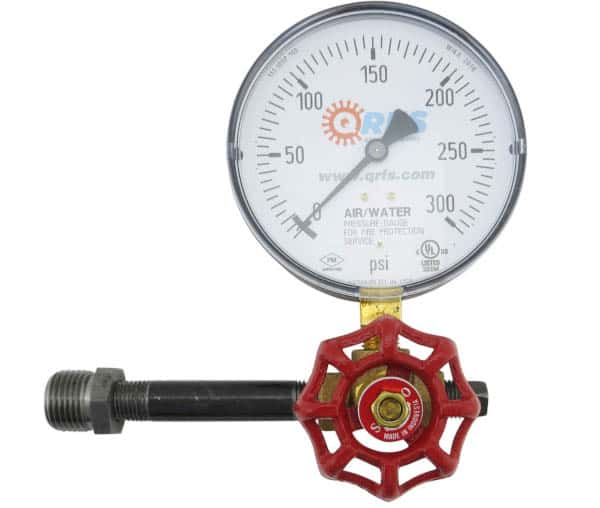How to choose a fire sprinkler system gauge
Fire sprinklers operate during a fire’s early stages to suppress or control flames, making them critical in the fight against commercial and residential fires. And it is the sprinkler system gauge — installed at various points throughout the system — that provides building owners and fire protection pros an easy, visual way to prove the system has an adequate supply of pressurized water or air. Sprinkler gauges are needed to ensure fire sprinkler systems are ready to fight fires.
This blog discusses what to look for when purchasing sprinkler system gauges, including the necessary certifications required by fire protection standards. It also outlines how to ensure your current gauges are working correctly, what parts are needed to install one in a new sprinkler system, and some great gauge options. Looking to purchase high-quality sprinkler gauges? Browse our complete selection.
The functions and standards of gauges
Fire sprinkler systems utilize multiple sprinkler gauges to monitor either the air or water pressure required for adequate system performance during an emergency. Due to the ‘always on’ nature of a fire sprinkler system, gauges are almost permanently under pressure. As such, they must be able to stand up to the constant strain placed on them while consistently providing precise and accurate readings.
Recognizing the importance of quality fire sprinkler gauges, the National Fire Protection Association’s NFPA 13: Standard for the Installation of Sprinkler Systems requires them to meet certain size and connection requirements and be “approved” (2022 edition, section 16.13), which is a less stringent category than requiring them to be “listed” by a safety research and testing organization. That said, high-quality gauges are listed, meaning they have UL listings and/or Factory Mutual (FM) Approvals, and NFPA 13 notes that “most vendors provide an option to purchase a listed gauge.”
UL is a global safety science company with over 100 years of experience testing and certifying the safety of manufactured goods. Nearly every electrical appliance you own contains the UL logo! FM, on the other hand, is an insurance company that specializes in loss prevention and safety testing. An FM approval seeks to guarantee not only the safety of the product but also its reliability.
Through research and testing, both organizations make sure products adhere to widely used standards for safety and property loss prevention. These certifications provide building owners, contractors, firefighters, and regulators peace of mind. Sprinkler gauges that carry UL listings and FM approvals can be trusted to perform reliably.
For sprinkler system gauges, error-free performance is what counts most, and periodic upkeep is a must. Thus, property owners — most often, through licensed contractors — need to maintain their sprinkler systems and gauges following NFPA 25: Standard for the Inspection, Testing, and Maintenance of Water-Based Fire Protection Systems.
Here are the main ITM requirements that cover most gauges in wet or dry sprinkler systems:
From the 2023 edition of NFPA 25
13.2.4.1.1* Gauges shall be inspected monthly to verify that the gauges are operable and not physically damaged.
13.2.4.1.2 Gauges monitoring water pressure shall be inspected quarterly to verify that normal water supply pressure is being maintained.
13.2.4.1.3 Gauges monitoring air or nitrogen pressure shall be inspected monthly to verify that normal air or nitrogen pressure are being maintained.
13.2.4.1.3.2 Where air pressure supervision is connected to a constantly attended location, gauges shall be inspected quarterly.
Things to look for when inspecting sprinkler system gauges include obvious physical damage, noticeably inaccurate pressure readings, fluttering gauge pointers, anything that makes them difficult to read, and leaks in or around the gauge. In addition, gauges must be recalibrated to ensure their accuracy or simply replaced every five years:
13.2.4.2* Gauges shall be replaced every 5 years or tested every 5 years by comparison with a calibrated gauge.
13.2.4.3 Gauges not accurate to within 3 percent of the full scale shall be recalibrated or replaced.
To learn more about where gauges are required and when to replace them, read our in-depth blog.
What gauges and accessories are needed?
Installing a fire sprinkler gauge in a brand-new sprinkler system requires more than the gauge alone. Usually, a ¼ inch 3-way valve combined with a ¼ inch x 0-3 nipple, ¼ inch plug, and the gauge itself are all required. Conveniently, QRFS offers a sprinkler gauge kit that comes complete with all four items bundled together.
The sprinkler gauge within the kit, as you’ve probably guessed, carries both a UL listing and FM approval and has a 3.5-inch dial housed in a beautiful stainless steel case. It measures in both pounds per square inch (PSI) and Pascal unit (kPa) or, in other words, both water and air pressure. Don’t need the kit? No problem, it’s available as a stand-alone gauge as well!

QRFS also carries UL-listed and FM-approved air and water gauges made by Ashcroft, the world’s largest and most trusted gauge manufacturer. The key differentiator for any Ashcroft gauge is its technology, including PowerFlexTM movement which reduces pulsation and vibration, extending the gauge’s life while minimizing maintenance costs. Regardless of which gauge you choose, QRFS will always provide you with superior customer service and extremely fast shipping.
Procure UL and FM-approved fire sprinkler gauges today by clicking the link below:
Browse all fire sprinkler gauges!
This blog was originally posted by Jason Hugo and Cameron Sharp at blog.qrfs.com on April 22, 2016, and updated on December 1, 2022. If you like what you’ve read, check us out at Facebook.com/QuickResponseFireSupply or on Twitter @QuickRsponseFS.


